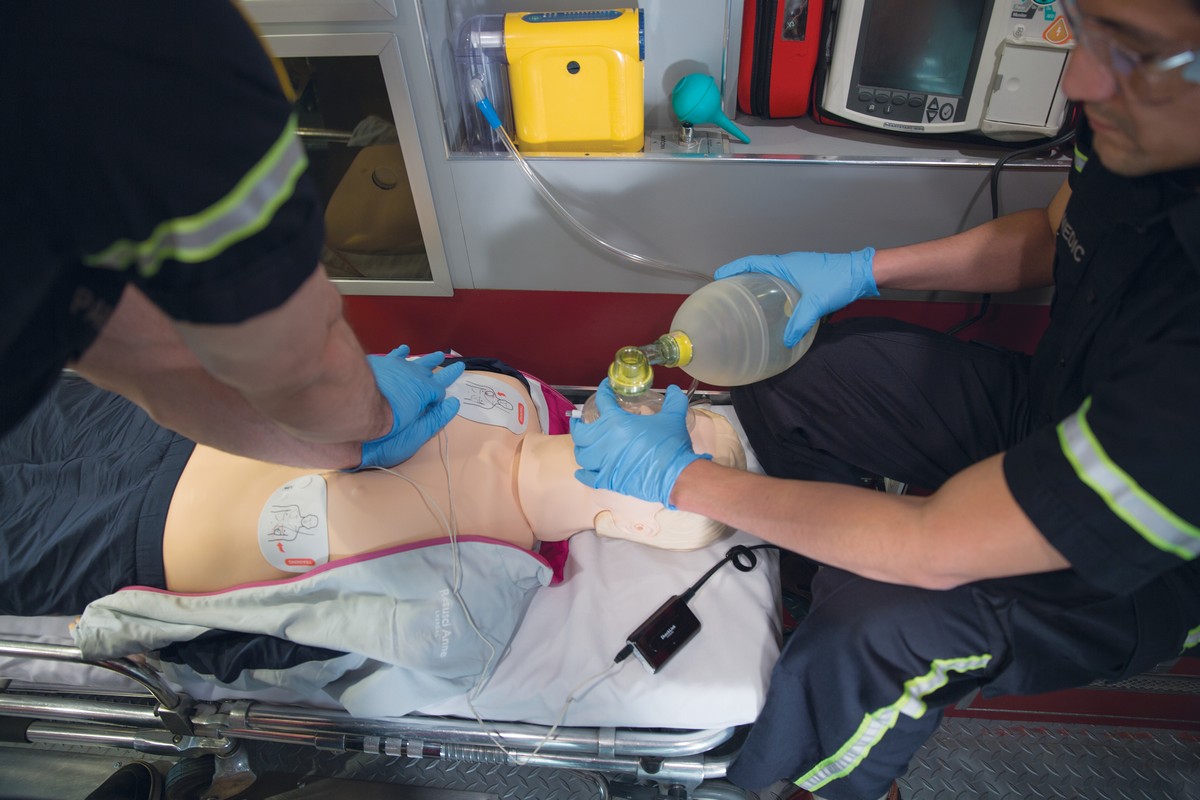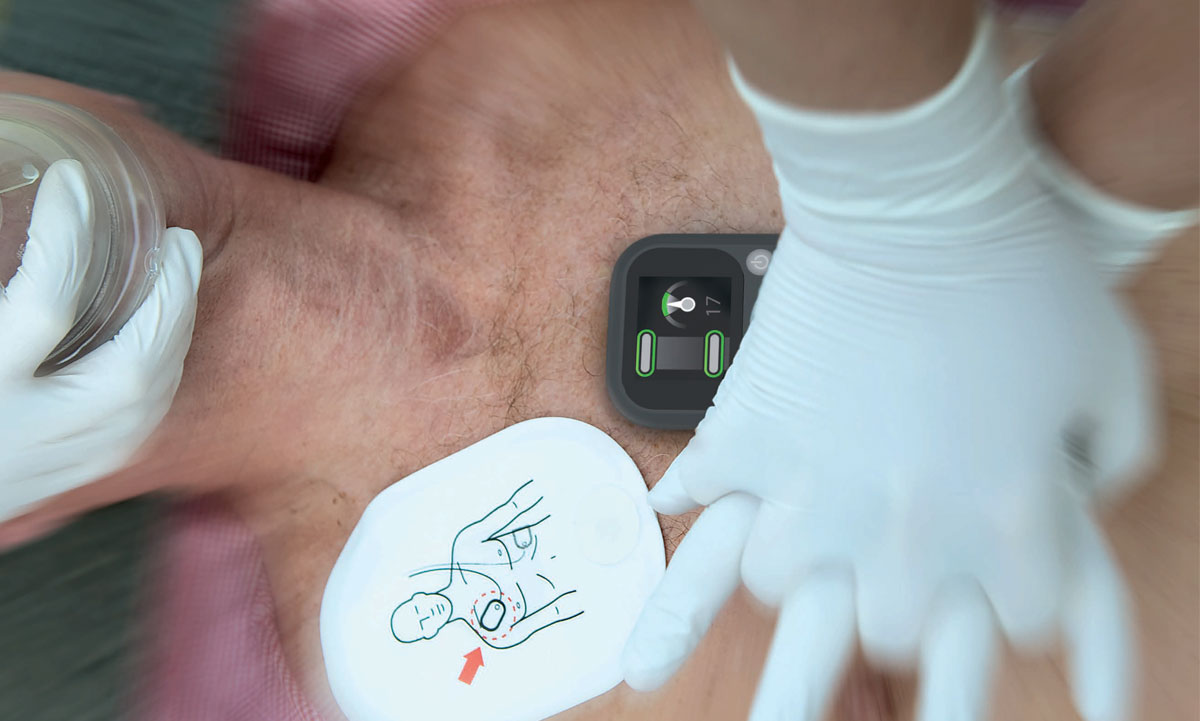CPR Good to Great
5 Reasons Why Real-Time Feedback Can Make the Difference
In this article, we share five reasons why real-time feedback can help providers and their organizations go from good to great in delivering CPR. Science and the experience of our customers agree, those who deliver the best CPR results employ real-time feedback as a means to:
- Improve defibrillation success
- Maximize perfusion pressure
- Adjust for chest stiffness
- Ensure engagement and ownership
- Continuously improve quality
1. Defibrillation Success
Have you ever taken a look at your defibrillation success? Here’s a scientific finding that every healthcare provider should know by heart. The longer your pre-shock pauses and the shallower your chest compressions, the less likely you will be to achieve defibrillation success.
This, of course, applies to a shockable rhythm, VF (ventricular fibrillation) and VT (pulseless ventricular tachycardia). And, if there were ever a case for using live feedback during CPR, the correlation between high quality CPR performance and defibrillation success is it.
This secret comes from a 2006 international multi- year study which concluded that each 5 mm increase in compression depth and each 5 second decrease in pre-shock pause portend an approximate two-fold increase in the likelihood of shock success after adjusting for arrest location, age, sex and time to shock.3
A two-fold increase is amazing. However, as this study and so many others have pointed out, providers are often missing the mark. Today’s technology, capable of sensing compression rate and depth, has shown that frequent pauses and shallow compression depth are common in clinical practice. 3
Certainly, there may be multiple reasons why a CPR provider would allow frequent pauses and shallow compressions to occur during CPR. Technique, stress, and loss of situational awareness can all be contributing factors. You can likely think of more. Real time feedback, however, can be used to mitigate those factors by guiding a CPR provider at the time those factors start to play their destructive role.
Rapid defibrillation remains the cornerstone of treatment for a shockable rhythm. Knowing that the science has determined that “longer pre-shock pauses and shallower chest compressions are correlated significantly with decreased shock success,” is reason enough to justify incorporating live feedback into your cardiac response program. If you don’t like your defibrillation success history, real-time feedback can help change that.

2. Maximizing Perfusion Pressure
While rapid defibrillation remains the cornerstone of treatment for a shockable rhythm, maximizing Coronary Perfusion Pressure (CPP) is the key to patient survival until defibrillation is available.
The main goal of CPR is to deliver oxygen and substrate to the brain and heart during cardiac arrest. To do this in a meaningful fashion, a provider has to perform CPR in a way presumed to maximize coronary perfusion pressure (CPP), the part of normal blood pressure that is specifically responsible for coronary blood flow.
In its 2013 Consensus Statement on CPR Quality (officially, CPR Quality: Improving Cardiac Resuscitation Outcomes both Inside and Outside the Hospital) the American Heart Association (AHA) spells out the key metrics that correlate to better hemodynamics and human survival. 4
• Chest compression fraction (CCF), i.e., the proportion of time chest compressions are performed during a cardiac arrest: >80%;
• Chest compression rate: between 100–120 compressions per minute;
• Chest compression depth: 2–2.4 inches for adults and adolescents;*
• Chest recoil: No residual leaning; and
• Ventilation: Less than 12 breaths per minute, minimal chest rise.
*To meet 2015 Guidelines we updated this from 2013 recommendation of >50 mm in adults and >1/3 anterior/posterior dimension in children and infants.
Without real-time feedback, you can probably imagine how meeting all these targets can be a challenge. The AHA has made it clear, however, that using real-time feedback to do so is critical. According to the AHA, monitoring of CPR quality is arguably one of the most significant advances in resuscitation practice in the past 20 years and one that should be incorporated into every resuscitation and every professional rescuer program.4 Real-time feedback can help CPR providers zero in on the best performance possible to ensure CPR success.
According to the American Heart Association, monitoring of CPR quality is one of the most significant advances in resuscitation in the past 20 years and should be incorporated into every resuscitation and every professional rescuer program.
3. Every Patient's Chest is Different
As part of a 2006 study on the force needed to achieve proper CPR compression depth,5 researchers confirmed something that you might consider obvious. Every patient’s chest resistance is different. Age and gender are factors. So is individual patient physiology. Of course.
Is it that obvious, though? According to the AHA, the majority of literature analyzing CPR performance suggests that rescuers often do not compress the chest deeply enough despite recommendations.4 If it is clear that every patient’s chest resistance is different, practitioners may still not be translating this into action during CPR. Real-time feedback can be part of the support practitioners need to ensure quality CPR, chest resistance notwithstanding.
Not only did the study validate that every patient’s chest resistance is different, it confirmed that chest stiffness decreases significantly with an increasing number of compressions performed during CPR.4 In 2006, that finding may not have struck practitioners as it might today. In 2006, there was no upper limit on compression depth. Post-2015 AHA Guidelines, there is: 2–2.4 inches for adults and adolescents.
If this seems overwhelming, keep in mind the objective of creating the best possible conditions for defibrillation success. The science shows that shallower compressions are associated with a decrease in defibrillation success. And, research published by the AHA suggests that compressions at a depth >2 inches may improve defibrillation success.4 The upper limit was added to deter injuries.6
Given that real-time feedback is now a readily available technology, achieving the right compression depth and setting the stage for defibrillation success should not be a guessing game. If you or your colleagues have ever felt like it is a guessing game, introducing real-time feedback into your program can help to eliminate that feeling.
The science shows that shallower compressions are associated with a decrease in defibrillation success. And, research published by the AHA suggests that compressions at a depth >2 inches may improve defibrillation success.

4. Autonomy, Not Autopilot
There is a variety of technology available to aid practitioners in meeting some or all of the five key metrics recommended by the AHA for delivering quality CPR. We support any means that enables practitioners such as yourself to save lives.
You’ve likely heard or used the phase, “I’m not in the loop”? “Sorry, I missed that detail. I’m not in the loop.” This expression comes from the U.S. Air Force concept of a “control loop” known as the OODA loop. OODA stands for Observe, Orient, Decide, Act.
When a pilot says he or she is “out of the loop,” it means being out of the control loop. The pilot can no longer observe, orient, decide, and/or act. Being out the OODA loop is a common risk associated with flying on autopilot. The pilot can unknowingly surrender autonomy and ownership to the autopilot feature.
The risk is the pilot will become disengaged from the OODA loop. He or she can become subject to a “vigilance decrement.” This refers to the finding that it is extremely difficult for humans to accurately monitor a repetitive process for long periods of time. The better an automated process works, the more it may encourage the user to zone out. The paradox is that in order to ensure safe operation,
the process still requires the user’s continuous attention.7 “Mode confusion” can develop, leading a user to believe that an automated process is working correctly when in fact it may not be.
Practitioner or pilot, both are high stakes roles in which autonomy and ownership are critical to success. Real-time feedback by its nature gives practitioners little choice but to be engaged in the OODA loop, which improves situational awareness, team performance, and individual attention to detail during CPR.
5. Continuous Quality Improvement
The adage, “if you don’t measure it, you can’t improve it” applies directly to monitoring CPR quality.4 The organizations most successful in improving outcomes from sudden cardiac have not only used real-time feedback during CPR, but have made the results of that feedback available for immediate and long-term review.
The AHA believes so strongly in this that it recommends that every EMS system, hospital, and other professional rescuer program should have an ongoing CPR CQI (Continuous Quality Improvement) program that provides feedback to the director, managers, and providers. CPR CQI programs can and should implement systems to acquire and centrally store metrics of CPR performance.4
That kind of program might seem like an undertaking, but the technology exists in today’s real-time feedback environment to record and easily provide the kind of feedback the AHA recommends. Among the benefits of integrating data from real-time feedback into an overall CQI program is that it gives providers an opportunity to focus on a long-term vision with long-term goals. Maximizing performance on the five key metrics of quality CPR becomes not only critical to each individual patient case but to the overall success and esprit of the organization. The use of real-time feedback as part of CQI effort is part of where King County EMS earns its credibility in its vision that “Everyone in VF survives."
Maximizing performance on the key metrics of quality CPR becomes not only critical to each individual patient case but to the overall success of the organization.
Summary
A review of institutions who have committed themselves to improving outcomes from sudden cardiac arrest shows a common theme. They have gone from good to great by in some way not accepting the status quo and maintaining an unwavering belief that in they end they would achieve their goals. King County certainly did this in their journey to achieve survival rates from sudden cardiac arrest that are five times the national average.
If you want to improve your CPR outcomes and you begin identifying matters by asking “Why?” five times, you may find that real-time feedback is a critical element that can help you go from good to great. Real-time feedback can help you create better conditions for defibrillation success, optimized hemodynamics, optimal compressions, provider ownership, and most importantly continuous improvement. Real-time feedback can give you the means to face possible current miscalculations in your performance, but also the assurance that you can and will prevail in improving performance.
If you would like to learn more about how real-time feedback can help you, please contact us.
References
1. Ask “Why” Five Times to Get to the Root Cause. (n.d.). Retrieved May 11, 2017, from http://www.ihi.org/ resources/Pages/ImprovementStories/AskWhyFiveTimestoGettotheRootCause.aspx
2. Heart Disease and Stroke Statistics - 2013 Update . (n.d.). Retrieved May 11, 2017, from http://cpr.heart.org/ AHAECC/CPRAndECC/General/UCM_477263_Cardiac-Arrest-Statistics.jsp
3. Edelson, D. P., Abella, B. S., Kramer-Johansen, J., Wik, L., Myklebust, H., Barry, A. M., . . . Becker, L.
B. (2006). Effects of compression depth and pre-shock pauses predict defibrillation failure during cardiac arrest. Resuscitation,71(2), 137-145. doi:10.1016/j.resuscitation.2006.04.008
4. Meaney, P. A., Bobrow, B. J., Mancini, M. E., Christenson, J., Caen, A. R., Bhanji, F., . . . Leary, M. (2013). Cardiopulmonary Resuscitation Quality: Improving Cardiac Resuscitation Outcomes Both Inside and Outside the Hospital: A Consensus Statement From the American Heart Association. Circulation,128(4), 417-435. doi:10.1161/cir.0b013e31829d8654
5. Tomlinson, A., Nysaether, J., Kramer-Johansen, J., Steen, P., & Dorph, E. (2007). Compression force– depth relationship during out-of-hospital cardiopulmonary resuscitation. Resuscitation,72(3), 364-370. doi:10.1016/j.resuscitation.2006.07.017
6. New resuscitation guidelines update CPR chest pushes. (2017, February 15). Retrieved May 11, 2017, from http://news.heart.org/%EF%BB%BFnew-resuscitation-guidelines-update-cpr-chest-pushes/
7. American, J. P. (2016, July 18). What NASA could teach Tesla about the limits of autopilot. Retrieved May 11, 2017, from http://www.pbs.org/newshour/rundown/time-seem-fly-faster-age/
